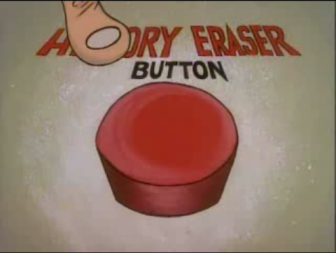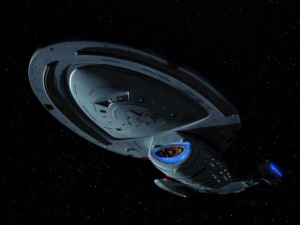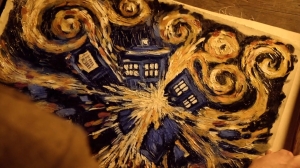A million years ago, you might remember I raked Battlestar Galatica over the coals for committing one of the great sins of fiction: “It was all part of God’s Plan.” Oh, I haven’t changed my opinion on that, or any of the other forbidden ways to end a story. No, today, I introduce a subheading to that most infamous and pathetic of conclusions, “It was all just a dream.”
And this variation is brought to us courtesy of a man in a blue box.

Continuing a tradition of horrifying Doctor Who photos.
Or, more to the point, brought to us by head writer Steven Moffat and writer Steve Thompson, the credited author of the most recent episode of Doctor Who, “Journey to the Centre of the TARDIS.” Now, this might surprise some of you, but in the thirty-odd combined seasons of both versions of the show, there is one resolution the Doctor has never resorted to. He’d sooner kill than actually do what he does at the end of this particular episode.

Don’t touch it, you fool!
Marked as a “big friendly button” the Doctor actually invades an earlier part of his own timeline (breaking the First Rule of Time) to hand himself a magic episode-erasing gizmo. The Doctor, not even contemplating the severity of the situation at all and trusting his future phantom completely, presses the red, candy-like button and undoes all but a minute of the episode.
Let it sink in.
While the show has mangled with the timeline before — particularly in the new series with Martha’s year that never happened and the Doctor rebooting the universe — it has never, ever in its broadcast history completely wiped out a story. Martha remembers the year that never happened. The Ponds and Rory remember the death of the universe and the Doctor’s subsequent sacrifice. Most importantly, the Doctor remembers everything. In this instance, even he is left clueless as the entirety of the episode is washed away from all but the viewers’ minds. You, as a viewer, might reach then end of the episode and feel a uncomfortable sensation, as though you might’ve been cheated out of something. That’s understandable because, even in the liberal storytelling circus that is Doctor Who, erasing the story you just watched is cheating.

Kind of like Exhibit A, here: the U.S.S. Dirty Rotten Cheater.
Star Trek: Voyager used this card far too often. Instead of dealing with interesting alterations to the show’s premise and facing the consequences, the writing staff always had a quantum filament or a divergent timeline or some other device to hand-wave away Chakotay getting killed. It’s cheap there and it’s cheap on Doctor Who. Undoing your plot is hugely problematic as a resolution to a story because it punishes the viewer (or reader) for getting invested in the story. The history-eraser button is tantamount to “it was all a dream” precisely for the way it damages the agreement between storyteller and listener. Both tactics take your willingness to participate as a set-up for a practical joke. Worse, once pressed, the button makes all stakes disappear. Tension evaporates in a situation when time is so fluid and mutable.
Granted, this is all second hand to me as Voyager‘s initial growing pains made me switch of the TV and do something else with my evenings. But I know it irked the viewership and it drove long-time Trek fans nuts. And I used to laugh from on high with a mad Doctor with questionable dress sense and a seemingly limitless ability to flout the rules of storytelling.
And then, at the center of the TARDIS, I found the one thing that could break the show. Somebody get Van Gogh, he needs to paint this.

Yeah, it would look something like that.
Now, some of you inclined to Doctor Who might ask, “But Erik, what if its part of Moffat’s master plan?” Allow me to laugh heartily because, if TV has taught us anything, it’s that no one ever has a plan: not the Cylons, not Chris Carter, not Jacob, and certainly not Steven Moffat. And even if he did, it’s a lousy way to plot episodes as single units of fiction. When building a serialized story like that, the narrative weight of all your plot holes comes back to haunt you and, well, remember how we never saw Cylon #7? Yeah, it’s happening here, too. Think about how the potential of the Silence was squandered in their few appearances. Consider how River’s plot keeps switching from her and the Doctor living their lives in opposite directions to the times she says their lives are merely out of sync; their meetings a whim of timey-wimey, spacey-wacey nonsense.
And really, if Moffat just chose one (I actually prefer the later), it wouldn’t be an issue, but it’s indicative of a far-reaching problem during his tenure as the boss. He wants to have these Whedonesque intricacies with a dash of his predecessor’s knack for setting up grand emotional releases. Sometimes, he does deliver on that, but it comes at the expense of satisfying episodes in and of themselves. The season-long puzzle is just more important to him.
Which brings us back to the history-eraser button. If “Journey to the Centre of the TARDIS” had to stand on its own as a story, it would’ve been scrapped in favor of the Doctor and Clara visiting the planet of the Wicker People. In the old days, the script editor would’ve rejected it at the outline stage, but “Moffat Has a Plan” leading up to the 50th Anniversary special and this episode served as a prequel. “Ooh, the audience gets to know things the Doctor doesn’t know. Aren’t I clever!” No, not really. Not like this. As head writer, it is his job to steer the show creatively and since its revival, the show has relied on a meta-arc to drive interest and momentum, but it’s hitting critical mass and you can only rely on it to smooth out rough episodes for so long.
So what’s the alternative you ask?
The previous episode, “Hide” is pretty close to being the template. It is a self contained unit, with the characters the Doctor and his companion meet becoming as compelling as the show’s leads. Well, compelling enough for the duration of the story. They do touch on the on-going Clara story, but only lightly. The Van Gogh episode from Moffat’s first year similarly delivers a satisfying self-contained episode that only lightly references an ongoing thread. I’m not whole against running themes or plot points, but the format should predominately be what kept the show going for the 26 years of its initial run: the Doctor and his companion arrive somewhere and help people become better at being people.
You don’t need a history eraser button for that.


